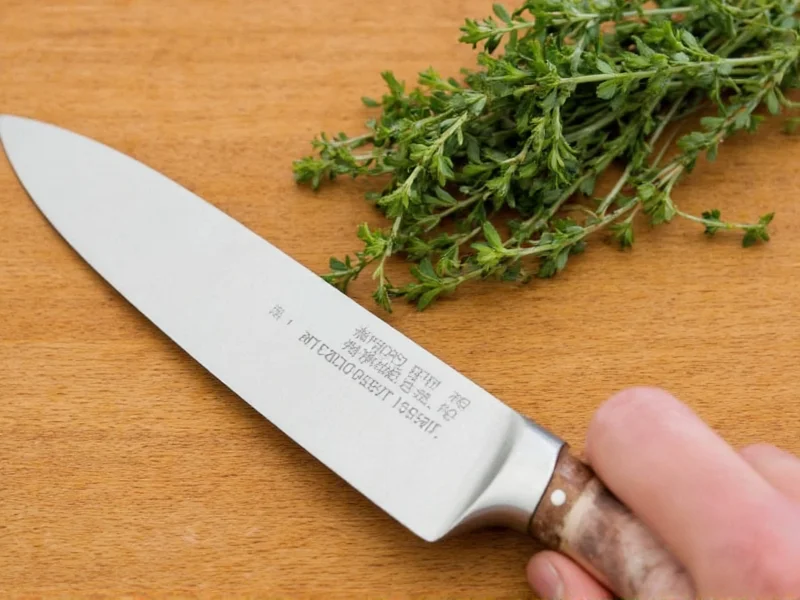Chopping thyme properly preserves its delicate flavor and aromatic oils, which can easily be lost with incorrect technique. Many home cooks make the mistake of chopping thyme stems along with the leaves, resulting in woody, unpleasant textures in their dishes. The essential oils that give thyme its distinctive flavor are concentrated in the leaves, not the tough stems.
Why Proper Thyme Chopping Technique Matters
Thyme's flavor profile changes dramatically based on how it's prepared. When you chop fresh thyme properly, you maximize the release of thymol and carvacrol—compounds responsible for thyme's earthy, slightly minty flavor. Over-chopping or using dull knives damages the plant cells excessively, causing oxidation that leads to bitter flavors. Understanding how to chop thyme without bruising the delicate leaves ensures your recipes showcase thyme's best qualities.
Essential Tools for Chopping Thyme
You don't need specialized equipment, but having the right tools makes a difference:
| Tool | Why It Matters | Alternative |
|---|---|---|
| Sharp chef's knife (6-8 inches) | Clean cuts preserve essential oils | Paring knife for small quantities |
| Stable cutting board | Prevents slipping and uneven chopping | Any flat, food-safe surface |
| Small bowl | Catches leaves during stripping process | Plate or parchment paper |
Step-by-Step Guide: How to Chop Thyme Properly
Step 1: Prepare Your Thyme
Remove thyme from packaging and rinse gently under cool water. Pat completely dry with a clean kitchen towel or paper towels. Moisture causes herbs to slip on the cutting board and dilutes their flavor. For how to prepare thyme for cooking, always work with dry herbs.
Step 2: Strip Leaves from Stems
This is the most crucial step in the proper technique for chopping thyme:
- Hold the thyme sprig vertically with the stem pointing up
- Grip the top 1-2 inches between thumb and forefinger
- Place your other thumb nail at the base of the leaves
- Slide your thumb downward firmly along the stem
- Leaves should detach cleanly and fall into your waiting bowl
Discard the bare stems—they're too woody for most recipes. This method preserves leaf integrity better than pulling individual leaves or using a fork.
Step 3: Gather and Mince the Leaves
For how to finely chop thyme leaves without bruising them:
- Gather the stripped leaves into a small pile
- Hold the knife tip with one hand while gripping the handle with the other
- Use a gentle rocking motion, keeping the tip in contact with the board
- Chop in short, controlled strokes—5-7 times is usually sufficient
- Stop before the leaves become paste-like
The ideal consistency is small, distinct pieces that still hold their shape. Over-chopping releases too much chlorophyll, creating bitter flavors.
Alternative Methods for Different Situations
While the hand-stripping method is best for most recipes, these alternatives work in specific circumstances:
For Large Quantities: The Fork Method
When preparing thyme chopping technique for recipes that require multiple sprigs:
- Place 5-6 sprigs on your cutting board
- Cover with an upside-down dinner fork
- Hold fork firmly and scrape downward along stems
- Collect leaves and proceed with chopping
This works faster but can slightly bruise more leaves than hand-stripping.
For Infused Oils or Stocks: Whole Sprigs
When making stocks, soups, or infused oils, how to prepare thyme for cooking differs—you'll want to tie sprigs together with kitchen twine for easy removal later. Never chop thyme for these applications, as the small pieces become difficult to strain out.
Storing Chopped Thyme
Chopped thyme loses flavor faster than whole sprigs. For best results:
- Use immediately for maximum flavor impact
- If storing, place in an airtight container with a paper towel
- Refrigerate for up to 24 hours (flavor degrades quickly)
- Freeze in olive oil in ice cube trays for longer storage
Never store chopped thyme in water—it dilutes the essential oils and accelerates spoilage.
Common Mistakes to Avoid
Learning what is the correct way to chop thyme means understanding these frequent errors:
- Chopping stems with leaves: Creates unpleasant woody texture
- Using a dull knife: Crushes rather than cuts, releasing bitter compounds
- Over-chopping: Turns leaves to mush, diminishing flavor quality
- Wet herbs: Causes slipping and dilutes essential oils
- Adding too early in cooking: Delicate flavors burn off—add near the end
When to Use Different Thyme Preparations
The best way to mince thyme leaves depends on your recipe:
- Fine chop: For sauces, dressings, and delicate dishes where texture matters
- Medium chop: For most sautéed dishes, roasts, and casseroles
- Whole leaves: For garnishes where visual appeal is important
- Whole sprigs: For soups, stews, and braises (remove before serving)











 浙公网安备
33010002000092号
浙公网安备
33010002000092号 浙B2-20120091-4
浙B2-20120091-4